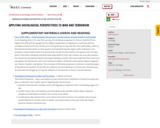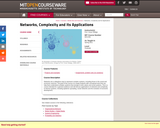
150 Results



OER Text MaterialThe Environment and Society, Section 20.3This subsection starts with Climate Change. It is noted that climate change is the term used to refer to long-term shifts in temperatures due to human activity and, in particular, the release of greenhouse gases into the environment. After defining pollution as what happens when contaminants are introduced into an environment (water, air, land), different types pollutions like water, soil, garbage, air, toxic and radioactive waste pollutions, are explained.

OER Text MaterialThe Growth of Cities, and Urbanization in the United States, Section 20.2The subsection, “the Growth of Cities” starts with explaining the three prerequisites for the development of a city. Another subsection, Urbanization in the United States, also addresses the learning objective. It is stated that “As more and more opportunities for work appeared in factories, workers left farms (and the rural communities that housed them) to move to the cities” developing urban areas.

OER Text MaterialTheoretical Perspectives on Urbanization, Chapter 20The Human Ecology theory, and the concentric zone modal are used to explain urbanization. Human ecology which is a functionalist field of study looks at the relationship between people and their built and natural physical environments. According to this theory, urban land use and urban population distribution occur in a predictable pattern once we understand how people relate to their living environment. The concentric zone model views a city as a series of concentric circular areas, expanding outward from the center of the city, with various “zones” invading adjacent zones.

OER Text MaterialUrbanizationAt this subsection, a suburb is defined as the communities surrounding cities which are close enough to the cities for a daily commute in and out of the city, but far enough away to allow for more space than city living affords. As the suburbs became more crowded and lost their charm, those who could afford it turned to the exurbs which is defined as communities that exist outside the ring of suburbs and are typically populated by even wealthier families who want more space and have the resources to lengthen their commute. Together, the suburbs, exurbs, and metropolitan areas all combine to form a metropolis. Apart from the definitions, suburbs and exurbs are explained in the chapter. Under the subheading, “Theoretical Perspectives on Urbanization,” the concentric zone model is explained.



OER Text MaterialSociology: Understanding and Changing the Social World, Section: 14.5 Some content available through OER for this objective – section 14.5, page 557: Stopping Terrorism. Efforts to stop terrorism take two forms (White, 2012). The first form involves attempts to capture known terrorists and to destroy their camps and facilities and is commonly called a law enforcement or military approach. The second form stems from the recognition of the structural roots of terrorism just described and is often called a structural-reform approach. Each approach has many advocates among terrorism experts, and each approach has many critics.

OER Text MaterialSociology: Understanding and Changing the Social World, Section: 14.5Limited content provided in section 14.5:- Distinguish international war and civil war.- List the major types of terrorism.- Evaluate the law enforcement and structural-reform approaches for dealing with terrorism.

OER Text MaterialSociology: Understanding and Changing the Social World, Section: 14.5Limited content in OER for this learning objective.Defining WarWars occur both between nations and within nations, when two or more factions engage in armedconflict. War between nations is called international war, while war within nations is called civil war. Themost famous civil war to Americans, of course, is the American Civil War, also called the War Betweenthe States, that pitted the North against the South from 1861 through 1865. More than 600,000 soldierson both sides died on the battlefield or from disease, a number that exceeds American deaths in all theother wars the United States has fought. More than 100 million soldiers and civilians are estimated tohave died during the international and civil wars of the 20th century (Leitenberg, 2006). Many novelsand films depict the heroism with which soldiers fight, while other novels and films show the horror thatwar entails. As Sydney H. Schanberg (2005), a former New York Times reporter who covered the wars inVietnam and Cambodia, has bluntly observed, “‘History,’ Hegel said, ‘is a slaughterhouse.’ And war ishow the slaughter is carried out.”

OER Text MaterialSociology: Understanding and Changing the Social World, Section: 14.5Some content available through OER for this objective – section 14.5, page 554 and 555: Types ofTerrorism:- Vigilante Terrorism- Insurgent Terrorism- Transnational Terrorism- State Terrorism

Sociology is the study of social groups, structures, processes, institutions, and events. This course will focus on understanding and applying the sociological perspective, which stresses the importance of the impact of social forces external to the individual in shaping peopleęs lives and experiences. This idea that we are all profoundly affected by the society in which we live is the guiding light of sociology. Sociologists also study the ways in which people, as they interact, shape their social systems. Topics studied will include socialization, social interaction, culture, groups, social structure, deviance, social inequality, social class, race, gender, institutions (political, economic, educational, family, and religious), collective behavior and social change. Students will be asked to learn the basic concepts, theories, and perspectives of sociology, to see how these operate in terms of social processes, structures, and events, and to apply this knowledge to better understand the social world.
- Subject:
- Social Science
- Sociology
- Material Type:
- Assessment
- Full Course
- Reading
- Syllabus
- Provider:
- Washington State Board for Community & Technical Colleges
- Provider Set:
- Open Course Library
- Date Added:
- 05/22/2019

Core subject for students majoring in management science. Surveys individual and social psychology and organization theory interpreted in the context of the managerial environment. Laboratory involves projects of an applied nature in behavioral science. Emphasizes use of behavioral science research methods to test hypotheses concerning organizational behavior. Instruction and practice in communication include report writing, team decision-making, and oral and visual presentation.
- Subject:
- Business and Finance
- Social Science
- Sociology
- Material Type:
- Full Course
- Provider:
- M.I.T.
- Provider Set:
- M.I.T. OpenCourseWare
- Author:
- Carroll, John S.
- Date Added:
- 01/01/2006

" This course is an examination of philosophical theories of action and motivation in the light of empirical findings from social psychology, sociology, and neuroscience. Topics include belief, desire, and moral motivation; sympathy and empathy; intentions and other committing states; strength of will and weakness of will; free will; addiction and compulsion; guilt, shame and regret; evil; self-knowledge and self-deception; and, virtues and character traits. This course is a CI-M course."
- Subject:
- Arts and Humanities
- Psychology
- Social Science
- Sociology
- Material Type:
- Full Course
- Provider:
- M.I.T.
- Provider Set:
- M.I.T. OpenCourseWare
- Author:
- Holton, Richard
- Date Added:
- 01/01/2009

Networks are a ubiquitous way to represent complex systems, including those in the social and economic sciences. The goal of the course is to equip students with conceptual tools that can help them understand complex systems that emerge in both nature and social systems. This is a course intended for a general audience and will discuss applications of networks and complexity to diverse systems, including epidemic spreading, social networks and the evolution of economic development.
- Subject:
- Social Science
- Sociology
- Material Type:
- Full Course
- Provider:
- M.I.T.
- Provider Set:
- M.I.T. OpenCourseWare
- Author:
- Hidalgo, Cesar
- Date Added:
- 01/01/2011

Examines theory and research on the relationship of organizations to each other and to their economic, political, and social environments. Classic and contemporary approaches to complex social systems, the dynamics of inertia and change, the role of legitimacy, and the production of change as an intended or unintended consequence. Considers the relative roles of voluntarism and determinism in the pursuit of organizational agendas and in the shaping of organizational environments, for example, with respect to changing employment relationships and environmentalism. Primarily for doctoral students. The goal of this doctoral course is to familiarize students with major conceptual frameworks, debates, and developments in contemporary organization theory. This is an inter-disciplinary domain of inquiry drawing primarily from sociology, and secondarily from economics, psychology, anthropology, and political science. The course focuses on inter-organizational processes, and also addresses the economic, institutional and cultural contexts that organizations must face. This is an introduction to a vast and multifaceted domain of inquiry. Due to time limitations, this course will touch lightly on many important topics, and neglect others entirely; its design resembles more a map than an encyclopedia. Also, given the focus on theoretical matters, methodological issues will move to the background. Empirical material will be used to illustrate how knowledge is produced from a particular standpoint and trying to answer particular questions, leaving the bulk of the discussion on quantitative and qualitative procedures to seminars such as 15.347, 15.348, and the like.
- Subject:
- Anthropology
- Business and Finance
- Economics
- Political Science
- Psychology
- Social Science
- Sociology
- Material Type:
- Full Course
- Provider:
- M.I.T.
- Provider Set:
- M.I.T. OpenCourseWare
- Author:
- Boczkowski, Pablo
- Date Added:
- 01/01/2004

Principles of Sociological Inquiry: Qualitative and Quantitative Methods also provides balanced coverage of qualitative and quantitative approaches by integrating a variety of examples from recent and classic sociological research. The text challenges students to debate and discuss the strengths and weaknesses of both approaches.
Finally, one of the most important goals Amy had for Principles of Sociological Inquiry: Qualitative and Quantitative Methods was to introduce students to the core principles of social research in a way that is straightforward and engaging. As such, the text reflects public sociology’s emphasis on making sociology accessible and readable. No one can validate that claim more than a teacher or student. So, take a look for yourself today and review Principles of Sociological Inquiry: Qualitative and Quantitative Methods by Amy Blackstone to see if its approach toward relevance, balance, and accessibility are right for your course and students.
- Subject:
- Social Science
- Sociology
- Material Type:
- Textbook
- Provider:
- The Saylor Foundation
- Author:
- Amy Blackstone
- Date Added:
- 05/22/2019

The professional world can be full of challenging situations, including conflicting personalities, miscommunication, and cultural differences. In this course, you will learn about typical workplace etiquette protocols, communication standards, and cultural awareness strategies in order to navigate these common obstacles as smoothly as possible.
- Subject:
- Business and Finance
- Material Type:
- Activity/Lab
- Full Course
- Homework/Assignment
- Reading
- Syllabus
- Provider:
- The Saylor Foundation
- Provider Set:
- Saylor Academy Professional Development
- Date Added:
- 10/24/2019

This course is designed to familiarize you with the major theory and research surrounding the study of small group communication and provide an opportunity to analyze and develop solutions to a community problem while working in a small group.
- Subject:
- Communication
- Communications & Media
- Material Type:
- Assessment
- Full Course
- Reading
- Syllabus
- Provider:
- Washington State Board for Community & Technical Colleges
- Provider Set:
- Open Course Library
- Date Added:
- 05/22/2019